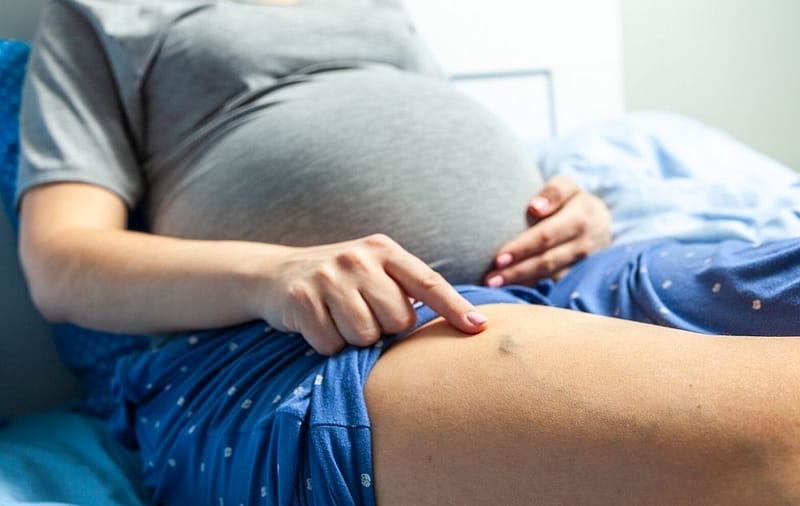What are prominent veins during pregnancy?
Prominent veins in the legs, which appear in women during pregnancy, are a very familiar phenomenon that bothers a high percentage of pregnant women. Varicose veins during pregnancy are formed due to a combination of several factors: genetic predisposition, hormonal changes, greater amount of blood present in the body during pregnancy and overweight. These factors along with other factors, also common to women who are not pregnant: prolonged standing while working (teachers, librarians, cashiers…), inactivity, which causes weakness of the leg muscles, whose proper function is important for venous blood flow causes prominent veins to appear.
During pregnancy it is not possible to treat prominent veins through surgery or injections.
How does that happen?
During pregnancy there is a greater amount of blood in a woman’s body. The amount of blood increases as the pregnancy process progresses (the excess blood the woman naturally loses during childbirth).
The function of the veins, to return the blood, after using them for the purposes of nourishing the body, with all the waste, upwards, back to the heart. Blood has a weight so it is difficult for blood to rise against gravity, from the feet towards the heart, through the veins. A process that takes place in every man, and in pregnant women there is another difficulty. The blood has to pass through the veins of the pelvis, which are in a state of stress because of the pregnancy that fills the pelvic area.
How does the blood return to the heart anyway?
While walking, the muscles of the legs contract and relax and “milk” the veins. The “venous milking” causes the blood to rise.
Prolonged standing at work, static standing without walking, is one of the causes of varicose veins in the legs and vice versa, daily walking is an important activity for normal blood flow.
It is recommended to go for a walk all days of the week and walk for at least 45 minutes. If the pregnancy is normal, and it is not a high-risk pregnancy, there is no prevention of physical exertion. The myth that a pregnant woman should rest is not true and it should be remembered that pregnancy is not a disability.
14
Walking and pregnancy How does it work?
Walking during pregnancy, as part of proper physical activity, may contribute to a woman’s body and the pregnancy process. Walking contributes on several levels:
During walking, the muscles “milk” the veins, so normal and strong venous blood flow returns the used blood towards the heart, towards the lungs and kidneys to refresh the blood (release CO2, oxygen dioxide, and get oxygen and get rid of acids and wastes). Walking lowers the pressure in the venous system and prevents varicose veins.
While walking you burn calories, thus avoiding unnecessary weight gain.
In the effort of exercise as walking, we sweat – sweating contributes to weight loss of the body thus avoiding it in unnecessary weight.
Strengthening the muscles – During pregnancy, the muscles are relatively weak as a result of congestion in the accumulated muscle due to hormonal changes.
Very important – finish the walk correctly.
During the walking effort, the heart pumps harder and faster, to provide the oxygen and energy needed for muscle function. Finishing the walk at once, will cause the heart to continue to pump fast and strong for a few minutes until it balances and returns to its normal rhythm at rest. At this time, a greater amount of blood reaches the legs, but the muscles do not work, as a result of stopping exercise. A sudden stop causes the veins to fill with a large amount of blood that does not return easily to the heart.
How do you do it right?
It is necessary to slow down the pace of walking in the last minutes of the walk – “Cool down” and at the end of the walk, lie down with raised legs for about five minutes.
Do hormonal changes affect the appearance of veins in the legs?
During pregnancy, hormonal changes occur in a woman’s body. Most hormones are secreted by the placenta that is in the wall of the uterus and only during pregnancy. Large amounts of the hormone “progesterone” affect connective tissue in the pelvic bones and vaginal walls and cause excessive flexibility.
This flexibility allows the fetus to pass through the birth canal. Without the effect of the hormones there is no flexibility in the pelvis and a caesarean section will be necessary.
These hormones also affect the vein wall and cause excessive flexibility. Thus the veins dilate easily because of the pressure of the blood present within the veins during pregnancy. The veins of the legs dilate so that the valves do not work well. Improper activity of the venous valves causes varicose veins to appear in the legs.
Important to know – At the end of pregnancy, after the birth of the fetus, the placenta comes out, so that the level of hormones in the woman’s body drops rapidly. The changes that have occurred due to over-flexibility are recurring. The dilated pelvic bones and the dilated vagina return to their natural place. This process also occurs in the vein area. The veins contract and over time disappear, all on the condition that the veins have not dilated too much.
When the veins have enlarged abnormally, the elastic fibers of the vein wall are torn and the veins remain forever. It is therefore advisable to prevent the dilation of the veins by external pressure on the veins, in order to resist the venous pressure and prevent the damage of the elastic fibers.
How to avoid pressure on the vein?
During pregnancy, it is recommended to use elastic stockings. The elastic stockings cause external pressure that does not allow the veins to dilate. There is a need for daily use of elastic socks, from morning to evening all days of the week.
The elastic stockings also prevent edema and fatigue of the feet, additional symptoms that appear during pregnancy.
Lying down and laying down with legs raised
Normal return of blood to the heart while standing works against gravity.
It is recommended for a pregnant woman, while lying in bed or resting, to do so with her legs raised. Blood return in this form takes place with the direction of gravity. Lying in bed with the legs raised allows the vein wall to contract so that the elastic fibers contract and rest and prevent them from tearing.
After delivery: A large portion of the dilated veins disappear, this process takes about three months.
It is advisable to consult a vascular specialist 3-4 months after delivery and not before.
What are the recommendations for preventing varicose veins during pregnancy?
Daily walk between 45 minutes and an hour


